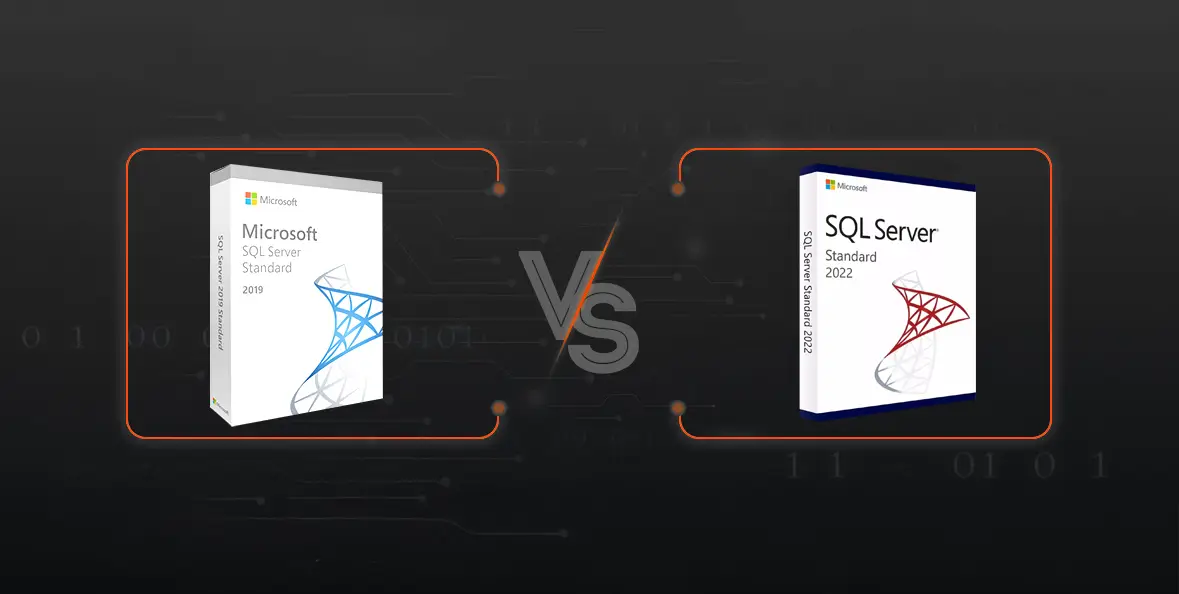When looking for an SQL Server to deploy in their IT infrastructure, organizations often jump to the latest version on offer by Microsoft – currently this is SQL Server 2022 which allures new customers with a prospect of deeper collaboration with Microsoft Azure services. However, it also brings important (and potentially quite costly) changes in its licensing terms and conditions, which should be carefully evaluated by customers who wish to avoid unnecessary spending, especially if it’s for features they do not need or use.
So what is different between SQL Server 2019 and SQL Server 2022?
Features
Click each feature below for details.
Intelligence
| SQL Server 2022 | SQL Server 2019 | SQL Server 2017 | ||
|---|---|---|---|---|
| PolyBase data virtualization |
|
|
|
|
| Data lake virtualization |
|
|
|
|
| Object storage backup and restore |
|
|
|
|
| Azure Synapse Link |
|
|
|
Availability
| SQL Server 2022 | SQL Server 2019 | SQL Server 2017 | ||
|---|---|---|---|---|
| Always on | ||||
| Accelerated database recovery | ||||
| Read scale-out availability groups | ||||
| Large memory and concurrency scalability | ||||
| Multi-write replication | ||||
| Link to Azure SQL Managed Instance – replicas | ||||
| Link to Azure SQL Managed Instance – unidirectional | ||||
| Link to Azure SQL Managed Instance – bidirectional | ||||
| Contained availability group | ||||
| Encryption at rest and in motion |
Performance
| SQL Server 2022 | SQL Server 2019 | SQL Server 2017 | ||
|---|---|---|---|---|
| In-memory database: in-memory OLTP |
|
|
|
|
| In-memory database: persistent memory |
|
|
|
|
| In-memory database: memory-optimized tempdb |
|
|
|
|
| Real-time operational analytics |
|
|
|
|
| Intelligent query processing |
|
|
|
|
| Buffer pool parallel scan |
|
|
|
|
| Query Store on by default with replica support |
|
|
|
|
| Query Store hints |
|
|
|
|
| Integrated acceleration & offloading |
|
|
|
|
| Hybrid buffer pool with direct write |
|
|
|
|
| Advanced Vector Extension (AVX) 512 extension to improve batch mode operations |
|
|
|
Security
| SQL Server 2022 | SQL Server 2019 | SQL Server 2017 | ||
|---|---|---|---|---|
| Always encrypted with secure enclaves | ||||
| Data discovery and classification | ||||
| Transparent data encryption | ||||
| Backup encryption support | ||||
| Encryption at rest and in motion | ||||
| Dynamic data masking and row-level security | ||||
| Microsoft Entra ID (formerly Azure Active Directory) authentication | ||||
| Microsoft Defender for SQL | ||||
| Microsoft Purview Integration central governance | ||||
| Microsoft Purview Integration data owner policies | ||||
| SQL Ledger | ||||
| Support for PFX certificates and other cryptographic enhancements | ||||
| MS-TDS 8.0 protocol and TLS 1.3 |
Programability
| SQL Server 2022 | SQL Server 2019 | SQL Server 2017 | ||
|---|---|---|---|---|
| Linux support | ||||
| Container support | ||||
| Kubernetes support | ||||
| Temporal tables | ||||
| JSON support | ||||
| Graph data support | ||||
| UTF 8 support | ||||
| Java support | ||||
| Database compatibility certification | ||||
| Bit manipulation functions | ||||
| Time series support |
BI and Analytics Support
| SQL Server 2022 | SQL Server 2019 | SQL Server 2017 | ||
|---|---|---|---|---|
| Integration services managed as a server | ||||
| Tabular BI semantic model | ||||
| Master data services | ||||
| Data quality services | ||||
| Many-to-many relationships in tabular models | ||||
| End-to-end mobile BI on any device | ||||
| SQL Server Analysis Services (SSAS) direct query | ||||
| Calculation groups in tabular model |
Azure-enabled
| SQL Server 2022 | SQL Server 2019 | SQL Server 2017 | ||
|---|---|---|---|---|
| Link to Azure SQL Managed Instance – replicas | ||||
| Link to Azure SQL Managed Instance – unidirectional | ||||
| Link to Azure SQL Managed Instance – bidirectional | ||||
| Optimized virtual machine (VM) images in Azure gallery | ||||
| Free asynchronous replication on Azure Virtual Machines for disaster recovery | ||||
| Microsoft Defender for SQL | ||||
| Azure Purview central governance | ||||
| Azure Purview data owner policies | ||||
| Microsoft Entra ID (formerly Azure AD) Authentication | ||||
| Azure Synapse Link for SQL |
Licensing
The basic licensing rules for SQL Server 2019 and SQL Server 2022 remain largely the same – both of them can be licensed either using the Per Core model or the Server+CAL model.
SQL Server Licensing Per Core
For the Per Core licensing model, an SQL Server core license has to be assigned to all physical cores on the server, with a minimum of 4 core licenses which have to be assigned for the SQL Server installation to be properly licensed. SQL Server CALs (client access licenses) are not required.
SQL Server Licensing Per CAL
With Server+CAL, one server license should be assigned for each server, and a client access license (CAL) for each device (Device CAL) and/or user (User CAL) accessing SQL Server or any of its components.
The most significant change lies in the virtualization rights for individual virtual machines.
Individual virtual machines are usually used by customers whose SQL Server instance uses only a fraction of the available computing resources of the server. Deploying databases as virtual machines (VMs) and allocating a limited number of cores to them reduces the number of required SQL Server core licenses that need to be purchased, which can result in considerable savings in licesing costs.
With SQL Server 2022 Microsoft introduced new conditions for this practice which reduce its cost-effectiveness in comparison to SQL Server 2019, as explained below:
SQL Server 2019 Per Core
Licensing of individual VMs requires the purchase of an SQL Server 2019 core license for each virtual core allocated to the VM, with an obligatory minimum of 4 core licenses per VM.
Under SQL Server 2019 Per Core licensing rules, Software Assurance subscription is not required in this scenario, and thus perpetual licenses can be used without any risk of losing license compliance with the terms and conditions set by the software manufacturer.
For all licensing rules, check the official SQL Server 2019 licensing guide.
SQL Server 2022 Per Core
Beginning with SQL Server 2022, licensing for individual VMs is available only under subscription licenses (like those coming from CSP, for example) or perpetual licenses with active Software Assurance.
This means that in order to license individual VMs using the Per Core model, all customers must purchase a core subscription license or a license with active Software Assurance for each virtual core allocated to the VM (with an obligatory minimum of 4 core licenses per VM).
For all licensing rules, check the official SQL Server 2022 licensing datasheet.
Note that for both SQL Server 2019 and SQL Server 2022 individual virtual machines can also be licensed with the Server+CAL model and in such cases an active Software Assurance is not obligatory.
Did you know?
It is still possible to purchase SQL Server 2019 Enterprise in the Server+CAL licensing model! To find out more, check the product description on our website.
SQL Server 2019 and 2022 licensing comparison table
| SQL Server 2019 | SQL Server 2022 | |
|---|---|---|
| Licensing model | Server+CAL; Per Core | Server+CAL; Per Core |
| Virtualization rights | available without Software Assurance for both Server+CAL and Per Core models | Software Assurance mandatory for the Per Core model |
| Supported operating systems | Windows 10 TH1 1507 or newer Windows Server 2016 or newer |
Windows 10 TH1 1507 or newer Windows Server 2016 or newer |
| End of support | 8.01.2030 | 11.01.2033 |




